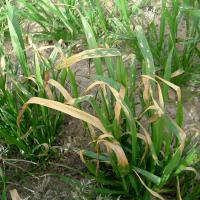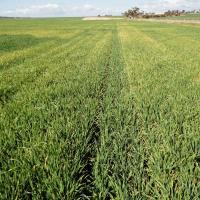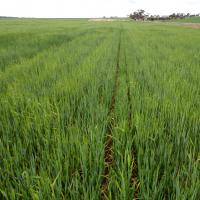Diagnosing foliar nutrient damage in cereals
Post-emergent (mainly sprayed) fertiliser can cause leaf scorching, but affected plants recover without any yield loss.
What to look for
- Areas of plants with scorched leaves.
- Wheeltracks may be less affected.
Paddock
- Scorched tissue on leaf tips and edges, leaf kinks, pale spots and irregular lesions on leaves.
- Damage is confined to leaves that were present at the time of spraying.
- Symptoms may be accompanied by herbicide damage and barley physiological leaf spot.
Plant
What else could it be
| Condition | Similarities | Differences |
|---|---|---|
| Diagnosing contact herbicide damage in cereals | Leaf tip death, pale spot lesions and leaf kinking | Herbicide damage is often more severe |
| Diagnosing spring drought in wheat and barley | Leaf tip death | Plants appear water stressed and older leaves are most affected |
| Diagnosing potassium deficiency in wheat | Leaf tip death | The older leaves of potassium deficient plants are most affected |
Where did it come from?

Wet conditions

Time of herbicide application
- Symptoms are likely to be worse in the following situations: Higher fertiliser rates are worse than lower rates if conditions favour damage.
- Tank mixes with some herbicides, particularly those known to cause crop damage in unfavourable situations.
- Actively growing, leafy crops that have not suffered any stress (so called 'soft crops') will suffer more visual leaf scorch than a 'tougher' crop.
- Damage has been observed to be worse on crops that are wet at the time of spraying or are sprayed under light, misty rain conditions.
- Very windy and high evaporative demand conditions enhance the potential for damage.
- Less damage has been observed on crops sprayed late afternoon as opposed to the relative heat of the day, or very early in the morning. Some varieties are more affected than others.
- Smaller droplets giving better leaf coverage and distribution may be less damaging than the same volume applied with larger droplets.
- Damage from top-dressed fertilisers is very uncommon, but has been observed when applied during misty rain conditions to leafy crops.
See also
Where to go for expert help
Page last updated: Wednesday, 17 May 2017 - 1:09pm





